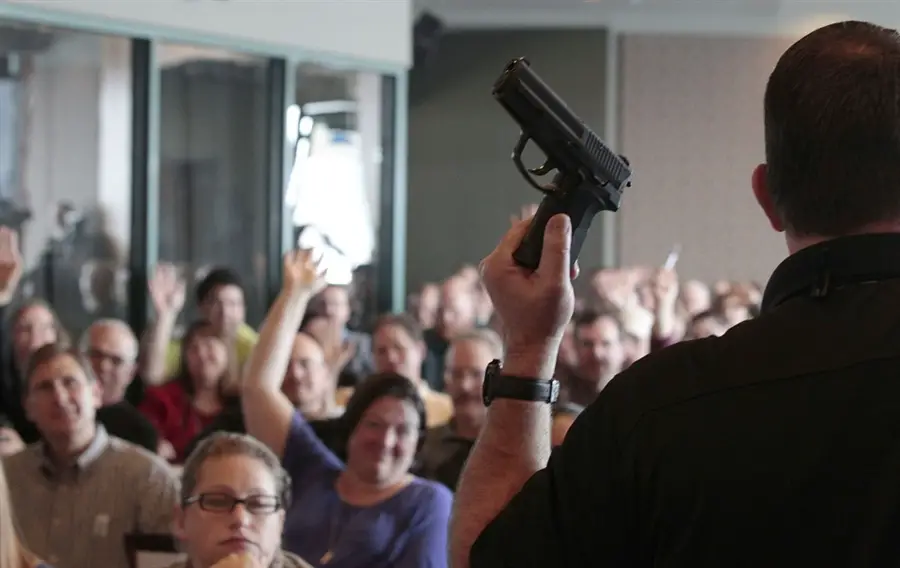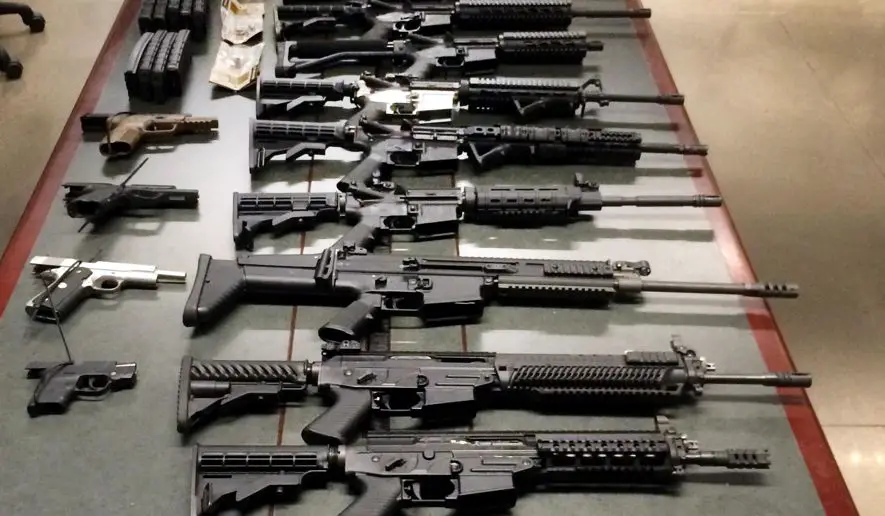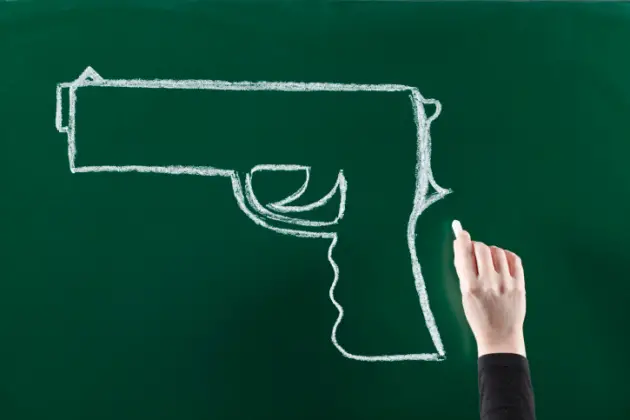Concealed Carry Curriculum
With the advent of campus carry laws, it’s time that students increase their knowledge on what it means to carry a firearm.
By Jeffrey Cope, Texas State University
Earlier this year, Texas Governor Greg Abbott passed legislation extending concealed carry laws to public universities, allowing for licensed students to bring firearms onto campus and into classrooms.
The legislation effectively put student safety right in the crosshairs of the political controversy between the pro and anti-gun lobbies, with both sides arguing endlessly for their own perspective on how to achieve a safer campus.
Let’s suppose, though, another solution—one in which all universities offer basic courses on the study of firearms.

The aim of the class would be for both groups to meet at the ideological middle of the issue, with gun-rights proponents getting the presence of their firearms, while anti-gun activists get the assurance of properly trained gun carriers.
Ideally, such a class would have an experienced and qualified instructor, and would cover the appropriate etiquette for carrying concealed firearms, proper emergency response actions and even some brief firearm history. From both an academic and practical point of view, the class would essentially act as an introduction to gun culture, a topic of study that would be worthwhile for students whether or not they plan on carrying.
In addition, by offering such a class, students would be expanding their understanding of other cultures, as an exploration of gun culture, a pivotal subject in the history of humanity, helps shed light on human behavior on a wide scale, from anthropology to psychology.
I’m not suggesting that universities build a gun range in the middle of campus; I’m simply entertaining the idea of a more structured, practical way to educate young people on firearms so that Hollywood isn’t left to do it.
I am by no means a gun expert, and am hardly even a novice, but I do appreciate some of the arguments for firearms and the desire for self-defense. So, I would like to see our institutions of higher education, especially in the U.S., offer realistic and constructive courses on firearm fundamentals as an approach to promote gun safety through gun knowledge.
This is America after all, where guns outnumber people.
I imagine the course-work of such a class would involve subjects similar to the following.
Gun Culture: Hollywood vs. Reality
As a kid, I certainly appreciated action movies and zombie videogames, and a lot of my initial ideas about guns were formed from these things. The endless capacity of ammo, the ease of aiming (unless of course you’re the bad guy, in which case it always seemed to be difficult) and the basic cool factor of winning the gunfight all informed my understanding of munitions. But, over the years, I’ve become more familiar with actual firearms, and I’ve learned that there’s a significant difference between the two worlds, primarily that there is nothing cool about gunfights.
In real life, guns demand a strong need for responsibility and training, and with the amount of firearms in the United States, it seems like it would be prudent for schools to offer an education on relevant firearm information. A basic gun class would help emphasize the fact that a real engagement with firearms is not the exciting and action-packed heroic moment that the movies make it out to be.
If students can carry guns onto campus, shouldn’t they be able to learn about them on campus as well?
Safety and Law
Undoubtedly the most important part of handling firearms is safety. Universities that are willing to offer safety-intensive courses that teach responsible gun ownership would provide a valuable educational resource to students who are choosing to take self-defense into their own hands. The class could help prevent the accidents that happen by mishandling firearms, which can tragically hurt the owners themselves or others.
In addition to teaching firearm safety procedures, it’s also important to provide students with a solid understanding of the state’s gun laws, as doing so can help safeguard young people from making simple legal mistakes. Students can be taught how to correctly respond to emergency services in order to document the event until official responders arrive. Educating students on the legalese of gun ownership ensures they know their limitations and the legal consequences of using a firearm.
In other words, you can carry, but there are things you need to know.
Training and Etiquette
Carrying concealed can be easier said than done, so by teaching students some effective carry methods and training techniques, students can then better avoid mishandling their firearms. This is so that in the event of an emergency, armed students can react faster and smarter, instead of unintentionally escalating the risk and endangering others.
By actively teaching students the appropriate actions that they can take when there is a threat of a weapon, whether by accident or in response to a real emergency, they can hopefully be mentally equipped to deal with the immediate dangers until help arrives.
Since welcoming firearms to campus, teaching students, whether they decide to carry a gun or not, to remain calm during an emergency, respond accurately to the threat and then properly comply with authorities, is a huge step forward in achieving an even safer campus.
Well-armed and now well-trained.
Identification
Learning the basic types of firearms and how they function would be just as useful, if not more useful, for students than having to learn the types of plants that are native to their state.

Knowing how to identify the types of poisonous plant species that are in my area could keep me alive, sure. But being able to identify the type of gun someone has could keep me alive just as well.
Gun identification is a big part of gun culture, and, more importantly, gun safety. By knowing how some of the most common firearms operate, you gain a better understanding of the threat that they pose and how you can react to them.
History
The early progress toward the invention of the gun followed the Chinese creation of black powder in the early eleventh century, which was then quickly used for firearms in the style of traditional cannons. Later, in the early sixteenth century, came the foundation of one of the world’s oldest and still-operating gun industries, Beretta, out of Italy, which began by incorporating the use of the flintlock firing mechanisms.
Since then, the presence of guns has expanded worldwide, and the lethal capabilities these weapons have never stopped improving. Guns have a complex history, in that while they provide the ability to enslave, they also provide the ability to be free. Now, with today’s downloadable and printable guns, firearms have certainly become one of humanity’s greatest equalizers.
Though I do recommend proper firearms training if you decide to carry, my suggestion that universities offer an introductory firearms course is not to be taken as a serious proposal.
I would, however, like to remind students that as they are now capable of armed self-defense against violent attackers on campus, they should consider further educating themselves on firearm knowledge and training, in order to be able to act appropriately.
In a free society, we should be willing to learn everything we can to fight against evil. So with campus carry in effect, I leave you by saying, “With great power comes great responsibility.”














A great column and a thoughtful proposal that warrants serious consideration.
Although the author’s approach to this hypothetical course primarily emphasizes pragmatic and practical topics, the inclusion of sessions devoted to the history of the second amendment and related court cases, the politics of the gun control and pro-gun lobbies, the psychological factors and social demographics influencing gun ownership, etc. could even justify the awarding of academic credit for the course.
I’m a bit surprised that the author seems to disown his own excellent suggestion. As both a university prof and gun owner, I think an introductory firearms course would make an outstanding course offering.
Although I am not sure there is such a thing as a “gun culture”, the idea behind such a course has merit, even though the author dismisses it after stating why it would be a good idea. In my opinion, the safety aspects should be a high school course. While the author dismisses the idea of a gun range on campus, that would appear to be a logical extension of the idea around the course, perhaps as an optional feature. Removing most of the misinformation about firearms and why people have them could only be a good thing as well as providing another means of becoming license capable if the students desire to follow up on that idea.
Re: ” my suggestion that universities offer an introductory firearms course is not to be taken as a serious proposal”
I agree – it should start in grade school around the time school officials are discussing birth control with adolescents. This “health” curriculum should be expanded to include the 4 rules of gun safety, how to store firearms and ammunition, how to safe and clear different types of firearms, the danger of being around firearms without hearing and eye protection, the penetrating power of various firearms, the difference between cover and concealment, the reports of various firearms (Students at Arapahoe High School in Colorado said they had never heard a real gunshot), how to recognize a firearm being out of battery, how to recognize a reload and how long it can take, and the list goes on.